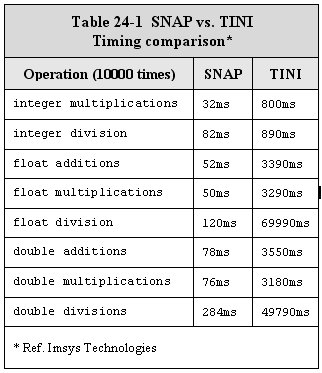
| Home : Course Map : Chapter 24 : Introduction : |
|
Java Processor Performance
|
| JavaTech |
| Course Map |
| Chapter 24 |
|
IntroEmbeddedJava |
| About
JavaTech Codes List Exercises Feedback References Resources Tips Topic Index Course Guide What's New |
|
Java processors, whether virtual or in hardware, vary greatly in their performance capabilities. Many embedded applications, such as controlling an appliance, do not require tremendous speed. On the other hand, some applications, such as creating detailed animations on a PDA screen, do require high performance. There is no universally accepted set of benchmarks of Java processing performance. One popular measure of Java processing speed, however, is the CaffeineMark developed by Pendragon Software (ef. Pendragon) in the mid-1990s. It consists of a suite of tests such as a prime number search, recursive method invocations, drawing images, and so forth. Another measure is the VolanoMark, developed by Jeff Neffenger, that focuses on sever performance (Ref. Volano). Benchmarks are what they are and you can always find some to enhance the features you want to stress. In general, it is best to focus on the particular platform and the features desired and compare only the systems that could fulfill those requirements. There is no point in comparing, say, a program running on the Javelin Stamp with a program running in a JVM on a desktop with the latest Pentium. The more advanced chips can perform at higher speeds and offer floating point but many still do not offer extreme performance. For example, in a series of tests involving tasks such as sorting and pattern recognition tasks, a 1.6GHZ Pentium gave roughly 100 times faster performance than an aJile evaluation board with the aJ-100 chip (Ref. Sikter). More of an oranges versus oranges comparison is given by the following table.
The table shows a comparison of speeds for several types of operations for the SNAP board from Imsys, which uses a hardware Java processor, and another TINI compatible board that uses a JVM running in a conventional microcontroller. For these tests, the hardware approach provides one to two orders of magnitude faster speed. References & Web Resources
Latest update: Dec. 15, 2004 |
